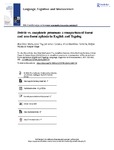Deictic vs. anaphoric pronouns: a comparison of fluent and non-fluent aphasia in english and tagalog

Ver/
Use este enlace para citar
http://hdl.handle.net/2183/40994
A non ser que se indique outra cousa, a licenza do ítem descríbese como Creative Commons Attribution 4.0 International License (CC-BY 4.0)
Coleccións
- Investigación (FCS) [1293]
Metadatos
Mostrar o rexistro completo do ítemTítulo
Deictic vs. anaphoric pronouns: a comparison of fluent and non-fluent aphasia in english and tagalogAutor(es)
Data
2024-07-18Cita bibliográfica
Thy ADM, Gerona J, Martínez-Ferreiro S, Popov S, Boye K. Deictic vs. anaphoric pronouns: a comparison of fluent and non-fluent aphasia in english and tagalog. Lang Cogn Neurosci. 2024 Jul 18;39(7):909-923.
Resumo
[Abstract] Deictic pronouns refer directly to the extralinguistic world (as in Stop her!), while anaphoric pronouns refer to elements introduced in discourse (as in My best friend is Mary. John adores her.). The distinction is central to linguistic theory and may be central also for understanding aphasia. This paper compares the production of deictic and anaphoric pronouns in fluent aphasia and non-fluent aphasia. It does so both for English and for Tagalog, which allows extensive omission of pronominal arguments. For both languages, the results show a dissociation between deictic and anaphoric pronouns. Non-fluent aphasic speech displays a lower proportion of anaphoric pronouns to non-pronouns than non-brain-damaged speech, while the proportion of deictic pronouns to non-pronouns is either not different (Tagalog) or higher (English). In contrast, fluent aphasic speech displays a higher proportion of deictic pronouns to non-pronouns, while the proportion of anaphoric pronouns is either not different (Tagalog) or lower (English).
Palabras chave
Deixis
Anaphora
Pronouns
Aphasia
Tagalog
Anaphora
Pronouns
Aphasia
Tagalog
Versión do editor
Dereitos
Creative Commons Attribution 4.0 International License (CC-BY 4.0)
ISSN
2327-3798






